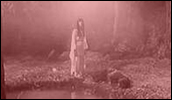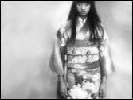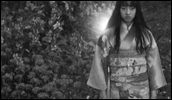Shikoku
- Year
- 1999
- Original title
- Shikoku
- Japanese title
- 死国
- Director
- Cast
- Running time
- 100 minutes
- Published
- 20 March 2001



by Jasper Sharp
Shikoku is the name of the fourth and smallest of the main islands that make up Japan, a mountainous rural province famed for its 1400 km long pilgrimage between the 88 temples established by the Buddhist saint Daishi Kobo (774-835), and a hotbed for the country's indigenous Shinto religion. The name means quite literally, Four ('shi') Kingdoms ('koku'), after the four original provinces of which it is comprised. Four is considered an unlucky number throughout much of Southeast Asia for the very reason that 'shi' is also the pronunciation of the Chinese character meaning death. This alternate rendering of the first kanji of the film's title is the central conceit of Shunichi Nagasaki's pedestrian addition to the late 1990s horror boom.
When, as a young girl, Hinako is drawn away from her hometown in the country by her parents' move to Tokyo, she loses contact with her best friend, Sayori. Years later, as a successful young career woman, she returns to Shikoku to sell the family home. It is only then that she discovers from another childhood friend, Sayori's teen sweetheart Fumiya, that Sayori drowned in a lake when she was 16. Since then Fumiya has always felt his dead lover's clinging presence hanging over him, scuppering any chance of a subsequent decent relationship. Sayori, like Hinako, had also harboured dreams of moving to the big city one day, and having rescued her best friend from a similar premature watery demise years before, has held a grudge against her ever since shuffling across the boundary dividing the living and the dead. Before long, her vengeful spirit begins to linger like a bad smell as Fumiya and Hinako start growing closer. Meanwhile a spate of shrine desecrations is sweeping across the island, with the heads of the stone Buddhist statues being forcibly smashed off. Sayori's mother has been undertaking a pilgrimage on a yearly basis ever since her daughter's death - but why does she seem to be following the 88-temple circuit backwards?
Shikoku's starting point is a children's story by Masako Bando, who grew up in the province's Kochi Prefecture. Another one of her works, Inugami, was adapted for the screen the following year by the same Asmik Ace Entertainment production group behind this film, directed by Masato Harada. However, it is clear to see where the true roots of Nagasaki's film lie.
Hideo Nakata's high-concept popcorn movie Ring had proven pretty convincingly that the supernatural could be a lucrative cash cow in late-1990s recessional Japan. A contract job, co-written by one of Ring's original producers, Takenori Sento, and circulating on the lower half of a double bill with Ring 2, Shikoku is less an indication of either Bando or Nagasaki's thematic interests than an obvious attempt to milk the current interest in horror before it dried up. As such, it doesn't deviate too far from the path forged by its model in either style or formula. At the core there's the same male-female investigative pairing pitting their wits against a central ghostly figure of a young girl in a white dress (Introducing the young Chiaki Kuriyama as the ghostly Sayori, later to appear in Battle Royale and Quentin Tarantino's Kill Bill), and an approach to the material that favours sedate and sombre chills over breakneck pacing and buckets of blood and grue.
Unfortunately, Nagasaki can do little with this material. Shikoku is never really particularly convincing as a horror, and, unable to capitalise on some earlier flesh-crawling moments, falls apart way before reaching its rather underwhelming showdown between Makoto Sato's renegade Buddhist priest and the forces from the darkside. Its greatest asset is perhaps the locale of Shikoku itself, shot in bleached out, hazy hues and long twilight shadows in the external scenes, and drenched out in the interiors by the shafts of natural sunlight that stream through the windows of Hinako's deserted property. Whilst not the worst offering from the late 90s horror cycle by any means, at the end of the day it's perhaps only Shikoku's backwater setting that really stands out.